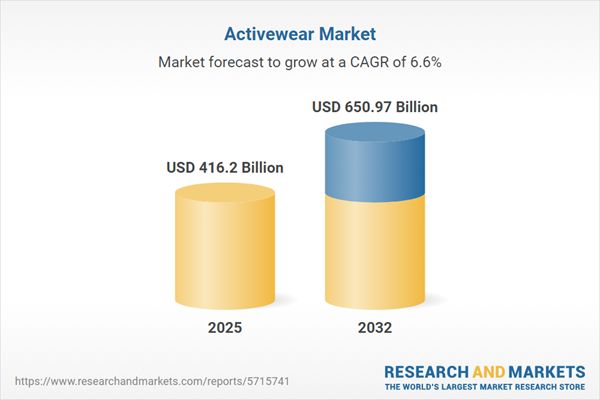Speak directly to the analyst to clarify any post sales queries you may have.
The activewear market requires continuous adaptation, challenging senior decision-makers to align strategies with rapid industry shifts and evolving consumer expectations. Achieving sustainable growth and resilience depends on business agility and informed, forward-facing leadership.
Market Snapshot: Activewear Market Growth Analysis
The global activewear market demonstrates robust growth momentum, increasing from USD 390.37 billion in 2024 to USD 416.20 billion in 2025, and projected to reach USD 650.97 billion by 2032. Fueled by a 6.60% CAGR, this expansion is driven by rising consumer interest in functional products that integrate technology and versatility. Brands are prioritizing sustainable manufacturing and advanced technologies, while optimizing digital retail channels to access wider and more diverse target audiences. Regional variations in cultural preferences and consumer behavior continue to influence product adoption, brand positioning, and differentiation strategies worldwide.
Scope & Segmentation: In-Depth Analysis of the Activewear Market
This report delivers executive-level insights across all dimensions of the activewear industry, enabling better informed, data-driven decisions amid sector complexity and rapid change.
- Product Types: Covers a complete spectrum, ranging from essential accessories like headwear and socks to technical bottoms, outerwear such as jackets and hoodies, performance sports bras, and multi-purpose tops designed for various activities.
- Distribution Channels: Addresses department stores, sports and specialty outlets, multi-brand retailers, as well as digital platforms including brand-owned websites, online marketplaces, and external retail providers.
- Gender Segmentation: Examines specific needs and preferences for men’s, women’s, and unisex activewear, detailing design trends and features tailored for unique performance and comfort demands.
- Age Groups: Explores market approaches for adults prioritizing adaptability, teens favoring athleisure-focused options, and children requiring enhanced comfort and durability.
- Pricing Tiers: Investigates the dynamics of luxury, premium, and mass-market segments, highlighting brand positioning, value delivery, and strategies for scaling or entering new markets.
- Materials: Tracks the adoption of blends, cotton, nylon, and polyester, with strong momentum toward sustainable, recycled, and branded fibers driving new design and environmental initiatives.
- Geographies: Evaluates commercial opportunities and market challenges across the Americas, Europe, Asia-Pacific, and the Middle East & Africa, considering local regulations and evolving consumer behaviors.
The competitive field includes leading brands such as Nike, adidas, Anta Sports, PUMA, Lululemon Athletica, Under Armour, ASICS, VF Corporation, Columbia Sportswear, and Fila Holdings. These companies are investing in material innovation and leveraging digital platforms to address diverse market requirements globally.
Key Takeaways for Senior Decision-Makers
- Sustainability increasingly shapes supply chain dynamics, as brands adopt eco-conscious materials and emphasize transparency to secure consumer trust and retailer partnerships.
- Digital transformation is accelerating through advanced personalization and virtual try-on technology, improving customer engagement and streamlining adaptation to trends.
- Collaboration across sectors broadens geographic reach and enables brands to appeal to new demographic groups, expanding their addressable markets.
- Operational agility, through made-to-order models and flexible inventory approaches, helps companies balance inventory and demand, mitigating overstock risks and supporting profitability.
- Omnichannel and hyperlocal retail strategies strengthen customer loyalty and allow precise adjustments for mature and high-growth regional markets alike.
- Designing and distributing products to fit regional regulatory and consumer requirements helps brands succeed in distinct markets with varied economic and cultural conditions.
Tariff Impact: Strategic Implications for Supply Chains and Pricing
In 2025, new US tariffs have reshaped cost structures for synthetic fibers and finished apparel. Activewear brands are responding by enhancing supplier networks, increasingly nearshoring production, and working with regional partners to offset pricing volatility. Strategic retail pricing and promotional campaigns aim to absorb cost pressures. Agile supply chain management and adaptive logistics have become priorities for maintaining competitiveness under shifting policies.
Methodology & Data Sources
This analysis leverages executive interviews, focused consumer surveys, and rigorous secondary research. All findings are validated with industry and government data and expert review to ensure decision-ready intelligence and comprehensive insights.
Why This Report Matters: Value for Executive Strategy
- Provides benchmarking tools to evaluate operational resilience, regulatory preparedness, and market strategy, aiding effective risk management.
- Guides optimal investments in sustainability and digital transformation, offering tailored recommendations for successful growth and regional expansion.
- Enables leaders to optimize resources and streamline operations with actionable, segmented regional and product insights.
Conclusion
Senior decision-makers equipped with actionable insights and strategic foresight can drive growth and navigate the evolving activewear landscape with confidence. This report supports operational agility and long-term market leadership.
Additional Product Information:
- Purchase of this report includes 1 year online access with quarterly updates.
- This report can be updated on request. Please contact our Customer Experience team using the Ask a Question widget on our website.
Table of Contents
3. Executive Summary
4. Market Overview
7. Cumulative Impact of Artificial Intelligence 2025
Companies Mentioned
The companies profiled in this Activewear market report include:- Nike, Inc.
- adidas AG
- Anta Sports Products Limited
- PUMA SE
- Lululemon Athletica Inc.
- Under Armour, Inc.
- ASICS Corporation
- VF Corporation
- Columbia Sportswear Company
- Fila Holdings Corp
Table Information
| Report Attribute | Details |
|---|---|
| No. of Pages | 181 |
| Published | October 2025 |
| Forecast Period | 2025 - 2032 |
| Estimated Market Value ( USD | $ 416.2 Billion |
| Forecasted Market Value ( USD | $ 650.97 Billion |
| Compound Annual Growth Rate | 6.6% |
| Regions Covered | Global |
| No. of Companies Mentioned | 11 |









